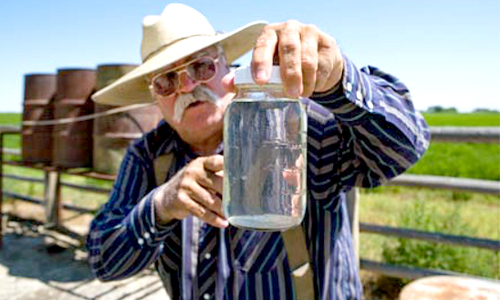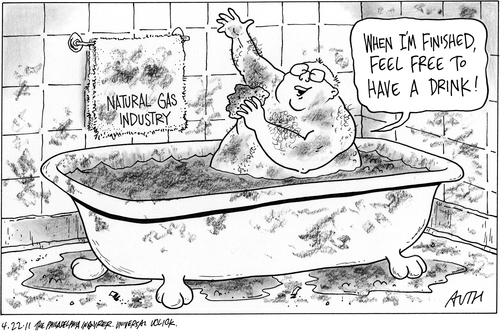
Pavillion, WY resident Louis Meeks’ holds up well water containing methane gas, hydrocarbons, lead and copper, according to the EPA’s test results in this 2013 photo. Photo credit: Abrahm Lustgarten/ProPublica
In 1990, residents of Pavillion, Wyoming first began to notice something was wrong with their water. Oil wells in backyards were causing tap water to turn black and taste like gas. Over 20 years later, in 2011, the U.S Environmental Protection Agency (EPA) finally made the connection between fracking and groundwater contamination (Zeidel et. al, 2011). Residents in Pavillion living on sites of wells drilled by oil giant Encana complained of foul smelling and undrinkable water in 2008, spurring the EPA to begin conducting tests. The EPA drilled wells of their own in the area and discovered the water tested was highly alkaline and contained large concentrations of potassium and chloride as well as synthetic chemicals, petroleum hydrocarbons and traces of diesel fuel (Zeidel et. al, 2011). The presence of these chemicals was linked to problems with the cementing of the casing used to line the wells, thus allowing the fracturing fluid to penetrate well water supplies (Zeidel et al, 2011). As a result, residents of Pavillion have experienced neurological impairment, loss of smell and nerve pain (Lustgarten, 2011).
Spokesman of Encana Doug Hock maintains that there is low probability that fracking has led to water pollution, however hydraulic fracturing is an inherently dangerous process, posing threats to water supply at all levels of production. Fracking only one well requires enough water to fill seven olympic sized swimming pools (Deveau, 2014). The extraction phase of the process requires water to be mixed with a toxic swill of chemicals (Deveau, 2014). During the injection process, fluids can leak to other areas. Leakoff, if not controlled, causes the injected fluids to leak into drinking water aquifers (Palliser, 2012).
After injection, the internal pressure of the rock formation causes the fluid to return to the surface. (Palliser, 2012). This is called flowback, a liquid containing both the injected chemicals as well as naturally occurring materials such as hydrocarbons, brines, metals and radio nuclides (Palliser, 2012). In order to be disposed of, flowback is often injected underground, or treated and reused at wastewater treatment plants. Problems occur with each method. In Ohio, the disposal capacity is being threatened by expanding flowback from Marcellus, a major fracking development in Pennsylvania. These limitations in disposal have led to the proposal of shipping brine waste to be deposited in the Gulf Coast (Downing, 2013). Furthermore, waste treatment plants used by fracking developments to treat and reuse wastewater are not equipped to remove contaminants such as chlorides and radio nuclides before the water is returned to rivers (Palliser, 2012).
Cases such as those in Wymoing illustrate the need for further control in the process of hydraulic fracturing if operations are intended to continue. A study by an endocrinologist in the U.S reveals that 75% of the chemicals used to frack disrupt sensory organs and the respiratory gastrointestinal system (Deveau, 2014).Given these statistics, the denial of fracking as a cause of groundwater contamination by companies such as Encana is extremely irresponsible, ultimately prioritizing economic growth over human and environmental health. This blunder is sure to become an issue of devastating proportions as we eventually discover that we cannot in fact drink our dollars.

image retrieved from http://drillingmoracounty.blogspot.sg/2011/04/poisoning-wells-fracking-wind-river.html
Sources and further reading:
- Palliser, J. (2012). Fracking fury.Science Scope, 35(7), 20-24. Retrieved from http://search.proquest.com/docview/927534588?accountid=13876
- Deveau, JL. (2014). How to Fight Fracking. Alternatives Journal. Retrieved from: http://search.proquest.com.libproxy1.nus.edu.sg/docview/1508764319?pq-origsite=summon
- Zeidel, M., O’Neil, L. (2011).US EPA Makes Connection Between Fracking and Water Pollution. The Oil Daily(c) 2011 Energy Intelligence Group. http://www.highbeam.com/doc/1G1-274587263.html